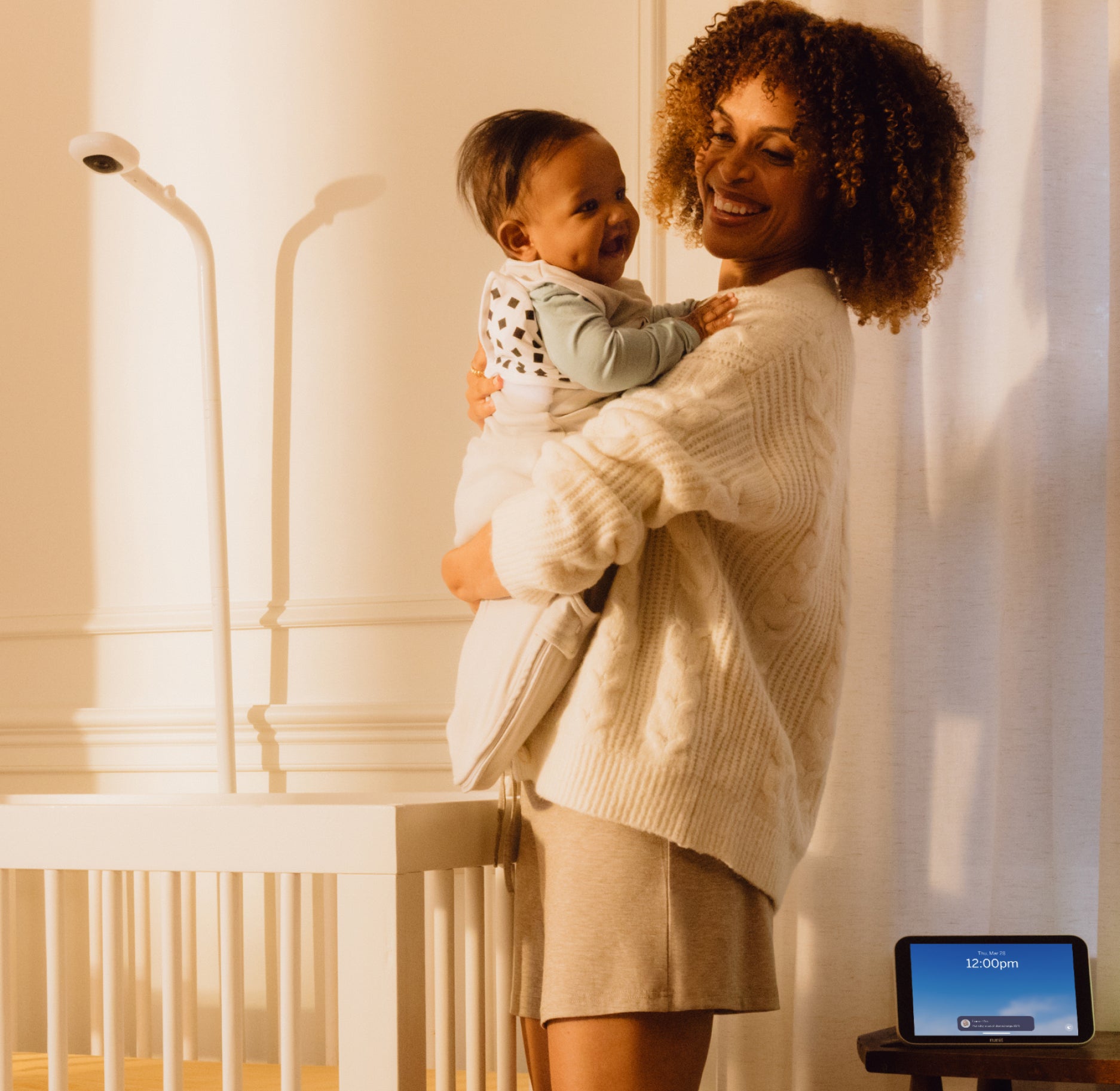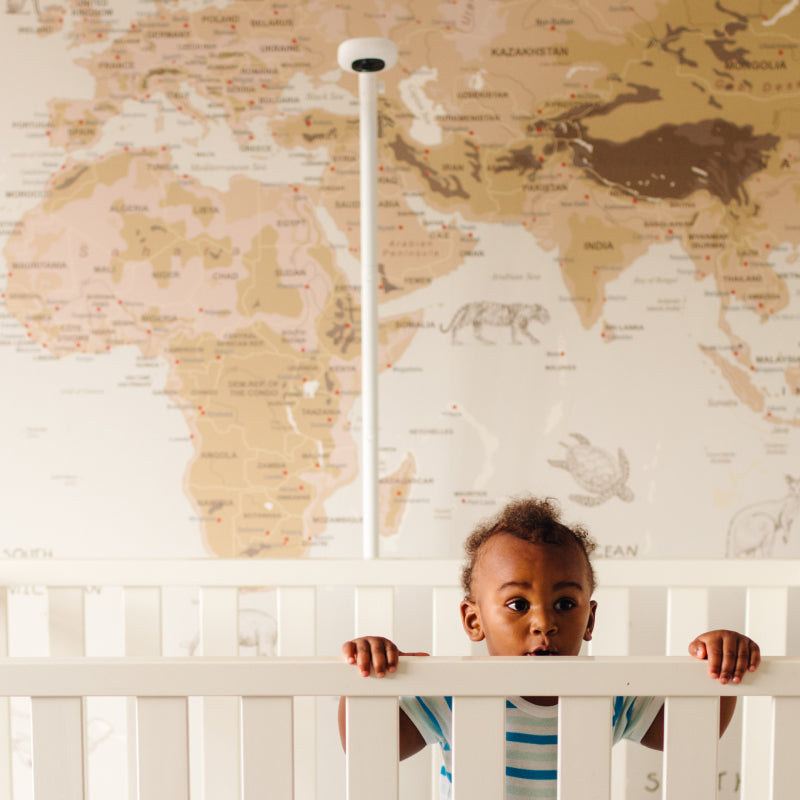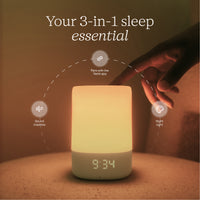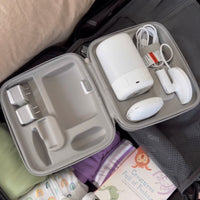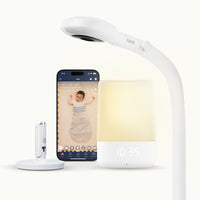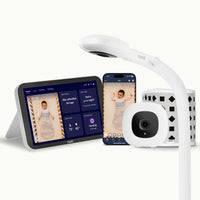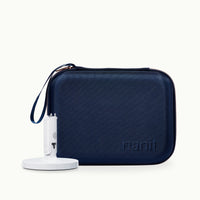Toddler on the move! [OR Toddler at large!] If only a warning sign could flash red every time it happens. Alas, it is a toddler parent’s fate to do their darndest to babyproof and take all necessary safety precautions—and then hope for the best.
Before your blood pressure shoots sky high, it can be reassuring to remember that some tumbles and trip ups can actually be a good thing, helping a child learn their (and the world’s) limitations and start to trust themselves and their own bodies. Your goal is to prevent serious hurt and harm.
And happily, we have some super safety experts helping us know how to do just that. In our Parent Like a Pro: Safe and Sound summit, baby and toddler safety pro Holly Choi of Safe Beginnings, pediatric physical therapist KC Rickerd of Milestones + Motherhood, and Nanit’s Senior Clinical Researcher Maristella Lucchini share their top toddler safety tips for protecting your young children.
- Think like a curious toddler. Take a glance around your home (or hotel room or the park) and try to see the space from your toddler’s perspective. What looks fun to climb? To grab onto and pull? “As an adult, would we want to eat out of a litter box?” asks Choi. “No, but would a toddler? Sure, totally! So being able to put yourself in their shoes is super important when it comes to creating safety environments for your preschooler.”
- Anchor furniture. Any heavy furniture—or furniture that can become top-heavy, like a bookcase loaded with items—should be securely anchored to the wall. This is a key toddler safety tip to prevent injury. Again, look at objects as a toddler might: “Could the dresser with its drawers pulled out look like stairs?” explains Choi. “Bookcases can look like a ladder. Kids see those and think, I can climb that and see what my parent is trying to keep me away from. And that’s when we have tip-over injuries.” For how-to-anchor tips, check out ChildproofingExperts.com or AnchorIt.gov.
- Safeguard stairs—and teach kids how to navigate them. Gates blocking off stairs are a must, according to both experts. And make sure you block off access at both the top and bottom of staircases. Experts recommend top of stair gates are hardware mounted, rather than pressure mounted, to prevent injury if the gate were to become dislodged. Additionally, “even if you have a gate set up, start teaching your child how to navigate the stairs as independently and safely as possible,” urges Rickerd, “through crawling up or scooting down on their butt, whatever feels best for your situation. I start that as soon as a child is moving and you’d be amazed at how quickly they catch on.” Check out Rickerd’s @milestones.and.motherhood IG account for helpful videos on teaching your little one these skills.
- Watch out for windows. Choi says that windows are one of the more overlooked hazards when it comes to toddlers. On a warm day, it’s easy to open a window wide…and forget about it and the threat it poses to a curious toddler. “Be mindful that kids love the sound of the garbage truck or a fire truck,” warns Choi. “They are drawn to the window to see what's going on outside, but babies and toddlers carry so much of their weight in their head that it’s easy for them to fall.” The safety rule golden rule: Limit your windows from opening wider than four inches, which is too narrow for kids to get their heads through. There are a variety of devices to help like a window guard. Search for “window opening control devices” to explore safe options depending on your home’s window style. “There is a solution for pretty much everything. I have some posts about it on my IG account @safebeginnings. Also, check with a window company if you're totally stuck or don't know what type of windows you have,” recommends Choi.
- Double check your car seat installation. You may think your toddler’s car seat is perfectly secure, but are you sure? Car seat safety is also another key safety measure to pay attention to.“Motor vehicle collisions are a leading cause of death for children and it's something that can be reduced by up to 71 percent if we're using a car seat correctly,” encourages Choi. “I've checked thousands of car seats and less than 10 percent of those I have seen were installed correctly.” Go to safekids.org to find resources near you who can double check your child’s car seat installation. And then run those errands with greater peace of mind..
- Make a “yes space.” Rickerds advises families to set up what she calls a “yes space” at home for your child, such as a cordoned off portion of a room or a portable crib, where your preschooler can be without you having to worry. “In a yes space, there's nothing that's off limits,” explains Rickerds. “Whatever’s there, your child can play with it. There’s nothing that you're going to have to run from the other side of the room and take out of their hands. They are safe, they're good, you can do what you have to do, be there with eyes on, but not stress that your child will stumble on or find something they shouldn't.”
- Be proactive with crib safety. As soon as your child starts to show signs of climbing or being interested in trying to get out of the crib, lower it to reduce the fall risk. “You can also dress your child for bed in a sleep sack so that they can't hike a leg over the crib railing,” suggests Rickerds. Your Nanit monitor can also serve as an extra set of eyes; Nanit’s Baby Standing feature alerts you in the case of your child standing up in their crib—which might be a precursor to climbing out! And the Nanit Sound + Light smart OK to Wake routine allows you to program in colored light cues that activate only when the Nanit Camera detects your toddler sitting or standing in the crib. When the camera picks up those movements, Sound + Light turns red to let your child know they need to stay in bed or green to signal it’s okay to get up for the day.
- Make sure the changing table is well stocked. Once your child is fully mobile, they’re unlikely to stay still for a second longer than they have to. So when you’re performing necessary tasks like dressing your child or changing a diaper, recommends Lucchini, either do it from a safe location like on the floor or, if you’re using an elevated changing table, make sure all your supplies are within easy reach. “You don’t want to be mid-change—and realize the wipes are on the other side of the room.”
-
Keep loose cords away from cribs. At all times, cords (like for a Sound + Light audio monitor) and other small objects should be at least three feet away from the crib to prevent any strangling, choking, or electrocution risks. For your baby monitor and other items kept near the crib, look for products with a cord cover. For example, Nanit’s ASTM Certified Pro Monitor with the Floor Stand or Wall Mount keeps the cable safely secured inside a metal tube.
- Babyproof pools. “Do it right now,” urges Choi. For pool proofing tips and resources for water safety awareness, check out the International Association for Child Safety and The Sylas Project.
- Get gadgets to help you. Pretty much every parent out there has wished they could be in a million places at once. “Technology can help bring you that peace of mind,” says Choi. In addition to the monitors and features already mentioned, Choi also likes Nanit’s Alert Zone feature, available with the Nanit Pro + Flex Stand Duo. “You can mark off inside the view of the camera what’s an okay place for your child to go and a not okay place. So for example, I usually mark off my office as a No Zone. So if I had a kid creeping towards my office, I could say to them [through the monitor], ‘That’s not the playroom, go back the other way.’”
And now that you know how to help your toddler stay safe(r) at home and in the world, here’s how to help them have the best sleep possible.



